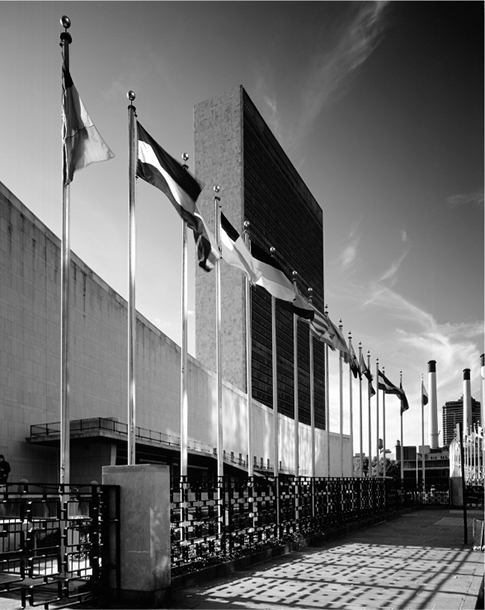
Working as a news correspondent at the United Nations has given me a firsthand perspective on one of the world’s most high-profile and important organizations. Nowhere else in the world can you watch an international group of diplomats, officials, and experts discuss the great challenges of our day and make decisions that can affect our lives for years to come. Addressing threats to international peace and security, promoting human rights, combating poverty and disease, and reducing the risks of international terrorism and the spread of weapons of mass destruction are among the big issues the UN can act on in a year.
Before the day’s decisions have been voted on at the UN, the agenda has been set and the diplomats and their staff have prepared themselves. Most disagreements have played out in relative privacy, and the public sees a polished performance. Many onlookers will accept this performance at face value and never give it another thought. For those who want to know more, who ask how the decisions were negotiated and reached and what their chances are for making a lasting impact, I have written this book, relying on my personal observations as well as the experiences and insights of other insiders.
Flags of member nations at the UN headquarters in New York City. UN Photo / Andrea Brizzi.
As the world has continued to change, so has the UN, which is experiencing a surge of activity as crises proliferate. In many of the recent crises we have seen a divided Security Council, where the United States and its allies, on the one hand, and Russia and China, on the other, have disagreed on how best to proceed. A prime example is the multiyear civil war in Syria. By the same token, the big powers have often agreed on increasing the number of the UN’s peacekeeping missions and on expanding their purview to include human rights issues. Human rights have attracted increasing attention from member states as important aspects of ensuring and protecting peace within nations and also of enhancing the UN’s efforts at social and economic development. The UN is also being asked to provide humanitarian aid much more frequently than before, in response to armed conflicts and to natural disasters like tsunamis and famines. Threats like international terrorism and the proliferation of nuclear and chemical weapons weigh ever more heavily on minds around the world. The UN has taken a more active role against terrorists and in the process has itself become a victim of terrorist attacks. Other global issues, such as climate change, are also rising in public awareness and in the UN. As a result, the UN’s general operations are experiencing a rapid budget escalation.
I was pleased when Yale University Press gave me the opportunity to update the book in a third edition. Once I began revising and updating, however, I found that the degree of change both inside and outside the UN has been so large in just the few years since 2009 that I had to rethink many of the chapters and write new ones—on the new international political landscape, humanitarian assistance, sustainable social and economic development, and the importance of the UN as a global coordinator and norm-setter. As part of my research, I interviewed more UN insiders, each with his or her own knowledge and experience with the world body. These new voices, I hope, give the book a more complex flavor and greater depth of information and insight.
Despite all the changes, the UN remains the world’s main multilateral forum and coordinator of international efforts to address common problems and issues. This book is arranged to provide the reader with a topical overview of how the UN works: its organization, governing principles, and key functions. The book begins with historical background and moves quickly to the UN’s chief executive officer, the secretary-general, and then to an examination of the new global political landscape. Succeeding chapters discuss the US ambassador and then the UN’s most prominent “principal organs,” the Security Council, including its peacekeeping operations, and the General Assembly. Next the book takes an informal trip through the UN Village, that little corner of New York City populated by diplomats from all over the world. In the final chapters, the book explores such global issues as international terrorism, nuclear proliferation, human rights and the responsibility to protect (R2P), and climate change. Other chapters look at the many agencies and programs that carry out the UN’s broad efforts in social and economic development, disaster relief, eradication of diseases, and reducing the trade in addictive drugs. The book concludes with chapters on the state of UN reform and finances and, in a final flourish, describes the experiences of a UN insider during his early days at the world body, as a staffer coping with the thousands of Vietnamese “boat people” who fled their country after the takeover by the North Vietnamese forces during the 1970s.
In the face of rapid and wrenching change, we have to wonder how an international organization created seven decades ago, in a very different world, can maintain its relevance and effectiveness today, let alone in the future. That is the UN’s greatest challenge—one that the insiders who run the UN and its associated agencies, the diplomats who represent its member nations, and the many experts who monitor and analyze the world body have also been asking. Most believe it can step up to the new challenges while reforming its own shortcomings, but that is by no means the unanimous view. I hope that this book will help readers make their own assessment of the UN’s current status and future prospects.